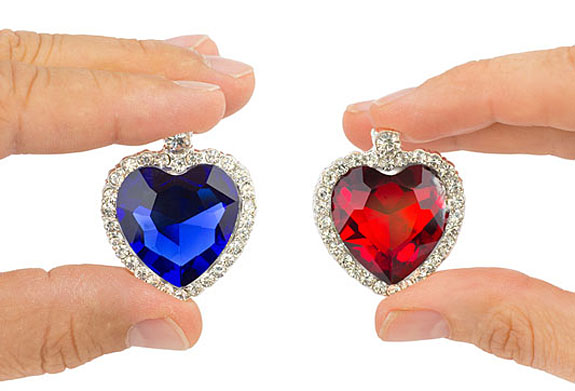February 9th, 2016
Romantic shoppers are set to spend $4.45 billion on necklaces, earrings and other jewelry items this Valentine's Day, according to a new survey published by the National Retail Federation (NRF). The jewelry category was narrowly edged out by "An evening out," which is expected to be the top category and generate $4.49 billion in sales. Flowers will lag well behind at $1.99 billion.

This year's Valentine-related jewelry purchases are predicted to be up 50.8% compared to 2010, when they tallied $2.95 billion.
The NRF reports that nearly one in five Valentine celebrants (19.9%) plans to purchase jewelry this year, with the average retail expenditure of about $166. By comparison, an average "evening out" is expected to cost $87, and the average gift of flowers will retail at $41.
Jewelry budgets will vary greatly, depending of the person's gender, income level and age.
For instance, men will outspend women $207 to $127, while those earning more than $50,000 per year will outspend their lower-earning counterparts by a tally of $191 to $126. Survey respondents ages 35 to 44 will be the most generous, spending $205, while the most cost-conscious age group (18- to 24-year-olds) will spend $126.
How much one intends to spend on a Valentine's gift also depends on who will be the recipient. Spouses will spend about $99 on each other, which is about double what they will spend on their children or parents ($50). Survey respondents also plan to buy gifts for co-workers ($54), friends ($36), children's classmates or teachers ($36) and pets ($26).
Overall, there are signs that people, in general, are less enthusiastic about Valentine's Day than they were in the past. Exactly 54.8% of respondents will celebrate on February 14, down from 63.4% in 2007. Despite the fall off in interest, total Valentine's Day retail spending is expected to climb to $19.7 billion, a survey high.
For the first time, the NRF asked consumers if they hoped to receive or plan to give a gift of "experience," such as tickets to a concert, a spa service or an art lesson. According to the survey, 24% said they plan to give a gift of experience, while nearly four in 10 (38.8%) said that they would love to receive a gift of experience.
“As the first major consumer holiday of 2016, Valentine’s Day could provide a positive boost in spending our economy needs,” said NRF President and CEO Matthew Shay. “Low gas prices and guaranteed promotions from retailers large and small should help consumers as they look for the perfect gift for their friends and family. Looking ahead, we’re optimistic consumers are in a good place when it comes to spending on discretionary items like gifts.”
The NRF’s 2016 Valentine’s Day spending survey was designed to gauge consumer behavior and shopping trends related to Valentine’s Day. The survey was conducted for NRF by Prosper Insights & Analytics. The poll of 7,293 consumers was conducted from January 5-12, 2016, and has a margin of error of plus or minus 1.2 percentage points.
Image: BigStockPhoto.com

This year's Valentine-related jewelry purchases are predicted to be up 50.8% compared to 2010, when they tallied $2.95 billion.
The NRF reports that nearly one in five Valentine celebrants (19.9%) plans to purchase jewelry this year, with the average retail expenditure of about $166. By comparison, an average "evening out" is expected to cost $87, and the average gift of flowers will retail at $41.
Jewelry budgets will vary greatly, depending of the person's gender, income level and age.
For instance, men will outspend women $207 to $127, while those earning more than $50,000 per year will outspend their lower-earning counterparts by a tally of $191 to $126. Survey respondents ages 35 to 44 will be the most generous, spending $205, while the most cost-conscious age group (18- to 24-year-olds) will spend $126.
How much one intends to spend on a Valentine's gift also depends on who will be the recipient. Spouses will spend about $99 on each other, which is about double what they will spend on their children or parents ($50). Survey respondents also plan to buy gifts for co-workers ($54), friends ($36), children's classmates or teachers ($36) and pets ($26).
Overall, there are signs that people, in general, are less enthusiastic about Valentine's Day than they were in the past. Exactly 54.8% of respondents will celebrate on February 14, down from 63.4% in 2007. Despite the fall off in interest, total Valentine's Day retail spending is expected to climb to $19.7 billion, a survey high.
For the first time, the NRF asked consumers if they hoped to receive or plan to give a gift of "experience," such as tickets to a concert, a spa service or an art lesson. According to the survey, 24% said they plan to give a gift of experience, while nearly four in 10 (38.8%) said that they would love to receive a gift of experience.
“As the first major consumer holiday of 2016, Valentine’s Day could provide a positive boost in spending our economy needs,” said NRF President and CEO Matthew Shay. “Low gas prices and guaranteed promotions from retailers large and small should help consumers as they look for the perfect gift for their friends and family. Looking ahead, we’re optimistic consumers are in a good place when it comes to spending on discretionary items like gifts.”
The NRF’s 2016 Valentine’s Day spending survey was designed to gauge consumer behavior and shopping trends related to Valentine’s Day. The survey was conducted for NRF by Prosper Insights & Analytics. The poll of 7,293 consumers was conducted from January 5-12, 2016, and has a margin of error of plus or minus 1.2 percentage points.
Image: BigStockPhoto.com



